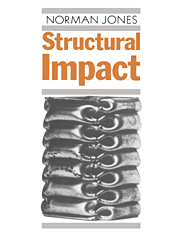Book contents
- Frontmatter
- Contents
- Preface
- 1 Static plastic behaviour of beams
- 2 Static plastic behaviour of plates and shells
- 3 Dynamic plastic behaviour of beams
- 4 Dynamic plastic behaviour of plates
- 5 Dynamic plastic behaviour of shells
- 6 Influence of transverse shear and rotatory inertia
- 7 Influence of finite displacements
- 8 Strain rate sensitive behaviour of materials
- 9 Dynamic progressive buckling
- 10 Dynamic plastic buckling
- 11 Scaling laws
- Appendices
- References
- Answers to selected problems
- Subject index
- Author index
Preface
Published online by Cambridge University Press: 09 January 2010
- Frontmatter
- Contents
- Preface
- 1 Static plastic behaviour of beams
- 2 Static plastic behaviour of plates and shells
- 3 Dynamic plastic behaviour of beams
- 4 Dynamic plastic behaviour of plates
- 5 Dynamic plastic behaviour of shells
- 6 Influence of transverse shear and rotatory inertia
- 7 Influence of finite displacements
- 8 Strain rate sensitive behaviour of materials
- 9 Dynamic progressive buckling
- 10 Dynamic plastic buckling
- 11 Scaling laws
- Appendices
- References
- Answers to selected problems
- Subject index
- Author index
Summary
Impact events occur in a wide variety of circumstances, from the everyday occurrence of striking a nail with a hammer to the protection of spacecraft against meteoroid impact. All too frequently, we see the results of impact on our roads. Newspapers and television report spectacular accidents which often involve impact loadings, such as the collisions of aircraft, buses, trains, and ships, together with the results of impact or blast loadings on pressure vessels and buildings due to accidental explosions and other accidents. The general public is becoming increasingly concerned about safety, including, for example, the integrity of nuclear transportation casks in various accident scenarios involving impact loads.
Clearly, impact is a large field, which embraces both simple structures (e.g., nails) and complex systems, such as the protection of nuclear power plants. The materials which are impacted include bricks, concrete, ductile and brittle metals, and polymer composites. Moreover, on the one hand, the impact velocities may be low and give rise to a quasi-static response, and, on the other hand, they may be sufficiently large to cause the properties of the target material to change significantly.
In this book, I have concentrated on the impact behaviour of ductile structures and, in particular, beams, plates, and shells. Most complex engineering systems are constructed largely of these simple structural members, so that an understanding of their response is an essential prerequisite for revealing the dynamic behaviour of a more complex system. The topic still remains a large one, and so I have specialised it further by focusing on large impact loads producing plastic strains which dominate the elastic effects.
- Type
- Chapter
- Information
- Structural Impact , pp. xi - xviPublisher: Cambridge University PressPrint publication year: 1990



